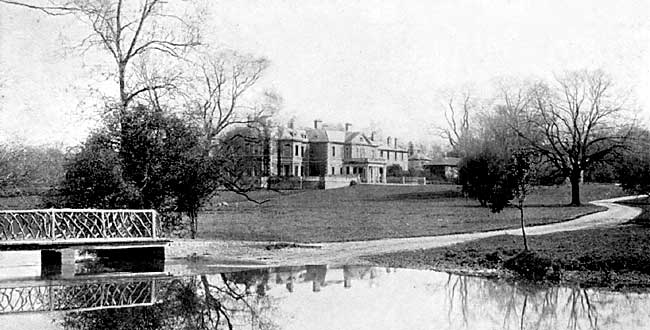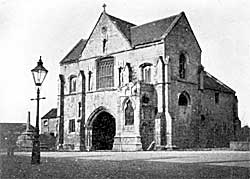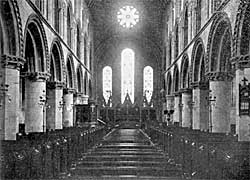The Retford Excursion.
AS the Royal Archaeological Institute held their Annual Meeting for 1901 at Nottingham in the month of July, it was thought well that the Thoroton Society should omit their Summer Excursion; but early in August arrangements were made for an Autumn Excursion, and on Thursday, the 19th September, about forty of our members and their friends visited the Retford District.
In good weather, a start was made in brakes from Retford Station about 10.15 a.m., and after an hour's pleasant drive, the extensive grounds and fine gardens of Osberton were reached.

Osberton Hall c.1900.
The Hall is a large house with a vast front of unbroken red cement. Upwards of twenty years ago its portico of Ionic columns was pulled down and replaced by the present structure, which is built of Roche Abbey stone. A new wing was added at the N.W. front, containing a dining-room, a fine library, and other apartments. The old library overlooking the park was converted into a billiard room; and on the site of the old drawing-room a central hall was built, spacious enough to contain the splendid collection of British birds, which was begun by Mr. F. F. Foljambe, the great-grandfather of the present owner.
Here our members were kindly received by Lady Foljambe, and our Chairman, Lord Hawkesbury; the latter of whom read a valuable paper, which will be printed in the Appendix to this volume, and in which he dealt with the history of Osberton and its neighbourhood.
The Osberton Collection of British Birds is said to be one of the most complete in existence, and contains two very exceptional specimens, one of the rare red-breasted goose, and one of the great auk. Other items of more local and antiquarian interest were the signet ring which belonged to the Abbot of Roche Abbey, an old Roman altar found at Littleborough (formerly the Roman station of Segelocum), and part of an altar piece from Beauchief Abbey representing the death of Thomas-a-Becket. Leaving the hall by a broad, massive staircase of oak, the members ascended the picture gallery above, where the family portraits are hung. The collection at Osberton, as will be seen from the lists given in our Appendix, contains also landscapes by Ruysdael, Van Ostade, Claude Lorraine, and interiors by Teniers.
After leaving the hall, the visitors walked over the lawns and through the gardens, and on meeting the brakes, which had meanwhile made a circuit, started about noon for Worksop Priory Church and Gatehouse, where they were met by the Vicar, the Rev. H. T. Slodden.

Worksop Priory gatehouse.
Before proceeding to describe the architectural history of the church, the Vicar gave a brief account of the ancient lords of the soil, with whose history the foundation and growth of the church was closely interwoven. Quoting from a book by Richard Nicholson, the architect who restored the church in 1850, he said the manor of Worksop, which had formerly been held by Elsi the Saxon, was given by William the Conqueror to Roger de Busli, whose principal residence was at Tickhill, a few miles away. From him it passed to Sir William de Lovetot, who founded the monastery about 1103. The lordship continued in this family for three generations, when Matilda de Lovetot was married to Gerard de Furnival, who thus became lord of Worksop in the right of his wife.
This Gerard de Furnival was a crusader, and served under Richard I. The manor remained in this family till the reign of Edward III., when a certain Lord Furnival was present at the battle of Crecy. Thence, the male line again becoming extinct, it passed to Sir Thomas Nevil by his marriage to an heiress of the Furnivals. This lady left an only daughter, who was married to the renowned John Talbot, Earl of Shrewsbury (vide Shakespeare's Henry VI.), and from this family the manor passed in 1617 to the Howards, the family of the Duke of Norfolk, with whom it remained till 1837, when it was purchased by the Duke of Newcastle. The present Duke of Newcastle sold the manor estate a few years ago, but still retained the manorial rights. At the coronation of the Sovereign the lord of the manor of Worksop has to find the king a right-hand glove and to support the Sovereign's right hand holding the sceptre.
The Priory Church of SS. Mary and Cuthbert, standing on the east side of the town, was originally cruciform, the choir with transepts having been used by the monks for their monastic services, whilst the nave was devoted to parochial services ; and it is to this fact that we owe the preservation of the rich, fine Norman nave, whose exterior only is mixed with later additions. This western portion is of eleven bays with clerestory and triforium, and is 135ft. long; the columns of the arcade being alternately round and octagonal.
The choir and transepts, which constituted the church of this priory of Austin Canons, have entirely disappeared, with the exception of a ruined thirteenth century chapel that formerly opened out of the south transept; and the present vestry with its vaulted roof was undoubtedly a part of the western buildings of the priory. When the monastery was dissolved in 1537, the arches which terminated the nave and aisles were walled up and the east end windows added about 1560. The triforium was particularly beautiful, and seems to have escaped the too complete renovation of fifty years ago, which is so conspicuous in the lower part of the church.
The arrangement of the round-headed windows of the clerestory is irregular and worthy of notice; for they are placed over the columns instead of over the arches of the nave. The roof of the church was formerly of oak, and nearly flat. The present dates from the time of the restoration in 1845 by Sir Gilbert Scott, and the font is also modern. All the old fittings of the church have disappeared as well as a series, in the south aisle, of square-headed windows, which lighted the parish altar and choir.

Interior of Worksop Priory church.
As regards its monuments, the church was formerly full of interest, for it was the principal burying-place of the Lovetots and Furnivals. We have it on good authority that Thomas de Furnival, the heir of the family, who was slain in Palestine in 1237, was buried in the church, having been, according to an ancient writing, brought home and "tumulated at Worksoppe on the north side of the minster." The architecture of an arch in the north aisle coincides with the date of Thomas de Furnival's death, but it is quite likely that the cross of St. Cuthbert to be found on the slab there, indicates the resting-place of one of the priors. The church has three figures in alabaster. A female figure which the present vicar has had placed at the western end of the church is supposed to represent Joan, wife of Sir Thomas Nevil and heiress to the house of Furnival, who died in 1406; and one of the male figures is probably that of one of the last of the Furnivals, possibly the Thomas, Lord Furnival who was at the battle of Crecy. After a close inspection of the interior of the church, the interesting remains of the monastic buildings on the north side of the church were visited ; on the top of a piece of the old wall a string-course seems to indicate that there has once been a building above it— possibly the dormitory. The gem of the monastic remains is the chapel known as S. Mary's Chapel at the eastern end of the south transept. When the present vicar, Mr. Slodden, came to Worksop, this building was in a dilapidated condition, and he called in an architect, who advised that a piece of rough masonry should be built up to keep the western arch from falling.
The date of the chapel is about 1250, and may possibly have been built by Maud de Lovetot, who by her marriage with Gerard de Furnival carried the Worksop estate to that family. The chapel appears to have been the burying-place of the Duke of Norfolk's retainers, and this may account for the fact that it has had more care bestowed on it than other parts of the monastic remains. A local tradition says that many of the beautiful carved stones of the ancient monastery were used for repairing the roads, and richly ornamented fragments are said to have been found in all sorts of unfrequented places, whither they had been carried by sacrilegious hands. The fourteenth century gateway was next visited. It is a very fine and a very complete example, presenting a gable to each point of the compass, and having a casual ward for tramps on the first floor. On the south side is the porch which formed the entrance to the stair-case leading to the large room above. In the richly canopied niche within the porch was formerly a shrine with a figure—probably that of the Virgin Mary. The porch is of later date than that of the rest of the building. The whole of the south front is full of detail and worthy of inspection. The niches on either side of the windows contain the figures of the Virgin Mary and of S. Augustine, whilst in the gable is a figure of the Holy Trinity. If the interior of the building has been beautifully embellished, the exterior was also possessed of the greatest charm until its ornamentation was ruthlessly destroyed. Even now they could just trace on the east side a sculpture of the Angel of the Salutation, and on the south side a representation of the adoration of the Magi.
